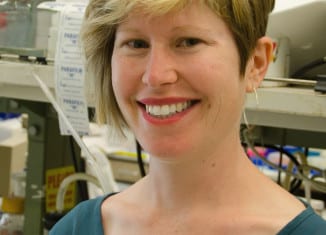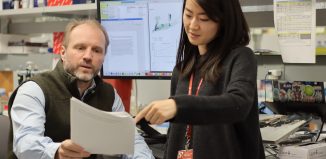Tollkuhn’s work at CSHL may provide clues for autism, mood disorders
Mickey Mouse, if he were a real mouse, would engage in typical male behavior: He’d be aggressive toward other males, he’d look for a mate, presumably Minnie, and he’d mark his territory.
Jessica Tollkuhn, an assistant professor at Cold Spring Harbor Laboratory, would like to uncover how and when signals from hormones trigger a series of genetic steps that lead to characteristic sex-specific behaviors. A molecular biologist by training, Tollkuhn joined CSHL last September.
Ultimately, understanding these steps may help with treatments for human conditions that have different outcomes, depending on the sex of the individual. “There are a lot of sex differences in mental health disorders,” Tollkuhn said. “Autism, ADHD and dyslexia are all more common in men and boys while mood disorders are more common in girls and women.”
While the steps from exploring sex differences in mice to extrapolations to humans are large, the types of experiments Tollkuhn conducts can provide a potential window into the molecular pathways that lead to these mental health challenges.
Tollkuhn’s studies exploring differences in the development of the male and female brain may “give us insights into how these circuits are different,” said Stephen Shea, an associate professor at Cold Spring Harbor Laboratory. Her work could “bring us closer to treatment” and to “understanding” the causes of the disparity in these mental health diseases between the sexes.
Shea is interested in species typical natural behaviors, including sexual behaviors in mice, he said. He studies those from a behavioral and circuit perspective, while Tollkuhn works on tools to understand how those are regulated at the genetic level. He said that has created “a natural collaboration for us.”
Tollkuhn works with neuroscientists at CSHL to connect behavior and development with the genetic steps that lead to those behaviors. She provides “a bridge between areas,” Shea said. “She has a multidisciplinary aspect that fits well with Cold Spring Harbor Laboratory, which unites people and draws links between separate areas.”
For Tollkuhn, mice present a model system that allows her to explore key moments in development. Researchers have shown that exposure to testosterone at birth, which is gone within 24 hours, leads to male mouse behaviors later in life.
Mice are born with almost all their neurons. The wiring occurs during their first two weeks of life, she said.
In the brain, an enzyme called aromatase turns that hormone into estrogen. The bump in the hormones in the brain “are necessary and sufficient to masculinize brain development,” in mice and other rodents, Tollkuhn said. “You can see changes in gene expression, in brain wiring patterns, and in behaviors” all from that narrow window of time.
Indeed, female mice that have estrogen in their brains during this critical early period become masculinized and will fight with other males when they get older. “Transient events in development have long-lasting effects on the brain and behavior,” Tollkuhn said. The cells in the brain that respond to the presence of hormone during development are located in the hypothalamus and the amygdala.
Tollkuhn said her long-standing interest is in understanding how genes define cell identity and function. In the brain, exploring how cells lead to behavior is a challenging question because scientists are just beginning to understand what each cell type does and how they are connected.
The sex differences are a model system Tollkuhn uses to understand the relationship between genes and behavior. She is studying how genes are turned on and off during development. The sex-specific behaviors of mice present opportunities to explore innate behaviors that don’t have to be trained.
In her work, Tollkuhn is profiling gene expression — looking at what genes are on or off — and chromatin — a combination of DNA and protein — in the brain. She’s doing this specifically in the neurons that have the receptor for estrogen.
Tollkuhn “has tools to assess chromatin,” Shea said. Tollkuhn has been “canny in developing or incorporating new techniques for sequencing DNA and understanding chromatin structure and she’s positioned herself at the forefront of those technologies.” Her greatest strength, he continued, is that she’s “put the pieces of these two worlds — the neuroscience of sex in the brain with these cutting edge techniques” together.
A resident of Huntington, Tollkuhn and her husband Joe Mulvaney, who writes software for scientists, have two sons. Franklin is four and a half and Linus is one.
Tollkuhn said she appreciates the family friendly environment at CSHL. “It’s nice to be somewhere where it’s not just okay, but it’s a positive to have family around at the lab and campus,” she said. She described her colleagues in the community at Cold Spring Harbor Laboratory as “fantastic.”
As for her work, Tollkuhn said she hopes to find new molecular targets for therapies and medications to treat mental health diseases.







